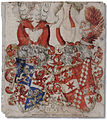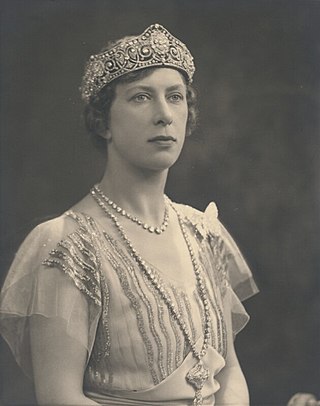
Mary, Princess Royal was a member of the British royal family. She was the only daughter of King George V and Queen Mary, the sister of kings Edward VIII and George VI, and aunt of Elizabeth II. In the First World War, she performed charity work in support of servicemen and their families. She married Henry Lascelles, Viscount Lascelles, in 1922. Mary was given the title of Princess Royal in 1932. During the Second World War, she was Controller Commandant of the Auxiliary Territorial Service. The Princess Royal and the Earl of Harewood had two sons, George Lascelles, 7th Earl of Harewood, and Gerald David Lascelles.

Anthony Woodville, 2nd Earl Rivers, was an English nobleman, courtier, bibliophile and writer. He was the brother of Queen Elizabeth Woodville who married King Edward IV. He was one of the leading members of the Woodville family, which came to prominence during the reign of King Edward IV. After Edward's death, he was arrested and then executed by the Duke of Gloucester as part of a power struggle between Richard and the Woodvilles. His English translation of The Dictes and Sayings of the Philosophers is one of the first books printed in England.
In heraldry, the field (background) of a shield can be divided into more than one area, or subdivision, of different tinctures, usually following the lines of one of the ordinaries and carrying its name. Shields may be divided this way for differencing or for purposes of marshalling, or simply for style. The lines that divide a shield may not always be straight, and there is a system of terminology for describing patterned lines, which is also shared with the heraldic ordinaries.

Charles Somerset, 1st Earl of Worcester, was an English nobleman and politician. He was the bastard son of Henry Beaufort, 3rd Duke of Somerset by his mistress Joan Hill.

In heraldry, cadency is any systematic way to distinguish arms displayed by descendants of the holder of a coat of arms when those family members have not been granted arms in their own right. Cadency is necessary in heraldic systems in which a given design may be owned by only one person at any time, generally the head of the senior line of a particular family.
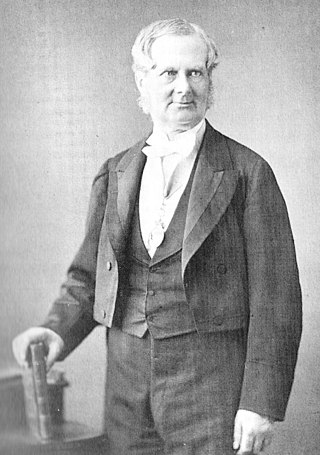
Sir John Bernard Burke, was a British genealogist and Ulster King of Arms, who helped publish Burke's Peerage.

Due to the differing role of women in past society, special rules grew relating to the blazoning of arms for women. The rules for women and heraldry developed differently from place to place and there is no one single rule that applies everywhere. In general, arms of women were most likely depicted not on shields but on lozenges or ovals. Different rules exist that depend on the woman's marital status and a married woman would also often make use of her husband's arms in addition to those from her family. In both the English and the Scottish systems of heraldry these differences remain active.
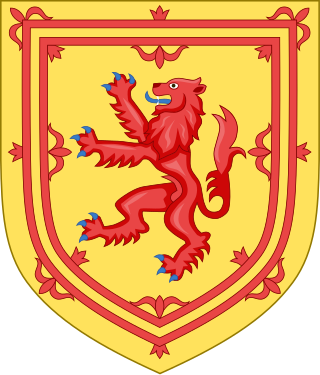
The coat of arms of Scotland, colloquially called the Lion Rampant, is the coat of arms historically used as arms of dominion by the monarchs of the Kingdom of Scotland, and later used within the coat of arms of Great Britain and the present coat of arms of the United Kingdom. The arms consist of a red lion surrounded by a red double border decorated with fleurs-de-lis, all on a gold background. The blazon, or heraldic description, is: Or a lion rampant Gules armed and langued Azure within a double tressure flory-counter-flory of the second.

Impalement is a heraldic practice in which two coats of arms are combined in one shield to denote a union. The impaled shield is bisected in pale, that is by a vertical line, with each half of the shield displaying one coat of arms. Most often the practice is used to denote the union of a husband and wife in marriage, but impalement is also used to display unions with an ecclesiastical office, academic position, government office, or mystical union.
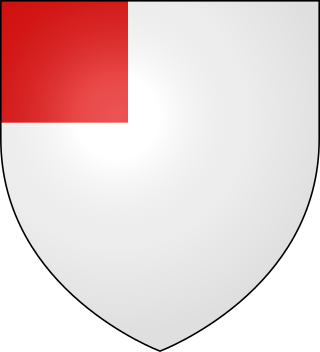
In heraldry, a canton is a charge placed upon a shield. It is, by default a square in the upper dexter corner, but if in the sinister corner is blazoned a canton sinister. A canton is classed by some heraldic writers as one of the honorable ordinaries; but, strictly speaking, it is a diminutive of the quarter, being two-thirds the area of that ordinary. However, in the armorial roll of Henry III, the quarter appears in several coats which in later rolls are blazoned as cantons. The canton, like the quarter, appears in early arms, and is always shown with straight lines.
In English law, baron and feme is a phrase used for husband and wife, in relation to each other, who were accounted as one person by coverture. Hence, by the old law of evidence, the one party was excluded from giving evidence for or against the other in civil questions, and a relic of this is still preserved in criminal law.

The House of Beaufort is an English noble family which originated in the fourteenth century as the legitimated issue of John of Gaunt, 1st Duke of Lancaster, by Katherine Swynford. Gaunt and Swynford had four children: John Beaufort, 1st Earl of Somerset (1373–1410); Cardinal Henry Beaufort (1375–1447), Bishop of Winchester; Thomas Beaufort, 1st Duke of Exeter (1377–1426) and Joan Beaufort, Countess of Westmorland (1379–1440). When Gaunt finally married Swynford as his third wife in 1396, the Beauforts were legitimized by Pope Boniface IX and by royal proclamation of the reigning monarch King Richard II the following year.

Infanta María Luisa Fernanda of Spain, Duchess of Montpensier was the younger daughter of King Ferdinand VII of Spain and his fourth wife and niece, Maria Christina of the Two Sicilies. She became Duchess of Montpensier by marriage to her first cousin once removed, Antoine, Duke of Montpensier.

In heraldry and vexillology, a heraldic flag is a flag containing coats of arms, heraldic badges, or other devices used for personal identification.

William Courtenay, 1st Earl of Devon, feudal baron of Okehampton and feudal baron of Plympton, was a member of the leading noble family of Devon. His principal seat was Tiverton Castle, Devon with further residences at Okehampton Castle and Colcombe Castle, also in that county.

English heraldry is the form of coats of arms and other heraldic bearings and insignia used in England. It lies within the so-called Gallo-British tradition. Coats of arms in England are regulated and granted to individuals by the English kings of arms of the College of Arms. An individual's arms may also be borne 'by courtesy' by members of the holder's nuclear family, subject to a system of cadency marks, to differentiate those displays from the arms of the original holder. The English heraldic style is exemplified in the arms of British royalty, and is reflected in the civic arms of cities and towns, as well as the noble arms of individuals in England. Royal orders in England, such as the Order of the Garter, also maintain notable heraldic bearings.

Sir John Chichester of Raleigh in the parish of Pilton, near Barnstaple in North Devon, was a leading member of the Devonshire gentry, a naval captain, and ardent Protestant who served as Sheriff of Devon in 1550-1551, and as Knight of the Shire for Devon in 1547, April 1554, and 1563, and as Member of Parliament for Barnstaple in 1559, over which borough his lordship of the manor of Raleigh, Pilton had considerable influence.

The landed gentry and nobility of Devonshire, like the rest of the English and European gentry, bore heraldic arms from the start of the age of heraldry circa 1200–1215. The fashion for the display of heraldry ceased about the end of the Victorian era (1901) by which time most of the ancient arms-bearing families of Devonshire had died out, moved away or parted with their landed estates.
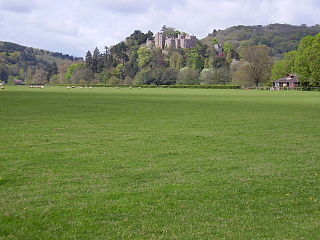
The feudal barony of Dunster was an English feudal barony with its caput at Dunster Castle in Somerset. During the reign of King Henry I (1100–1135) the barony comprised forty knight's fees and was later enlarged. In about 1150 the manors retained in demesne were Dunster, Minehead, Cutcombe, Kilton and Carhampton in Somerset, and Ham in Dorset.
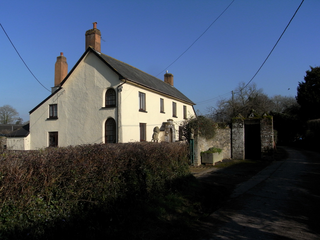
Moor Hays is a historic estate in the parish of Cullompton in Devon, England. It is stated incorrectly to be in the nearby parish of Burlescombe in Tristram Risdon's Survey of Devon. The estate is not to be confused with Moor Hayes in the parish of Washfield, about 3 miles north-west of Tiverton, another ancient farmstead, which since 2005 has been the site of a large housing estate named "Moorhayes".


